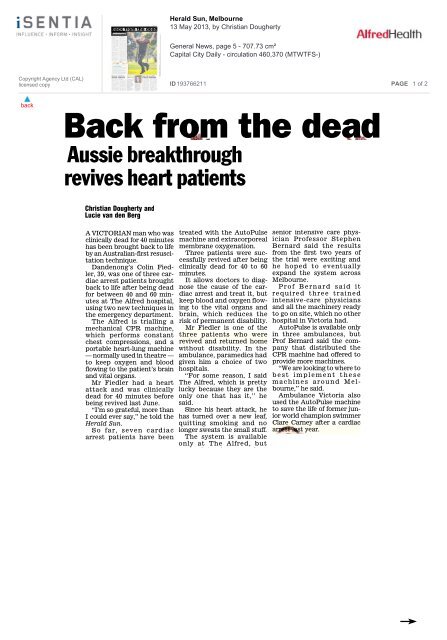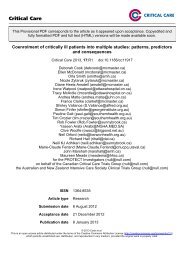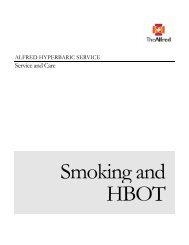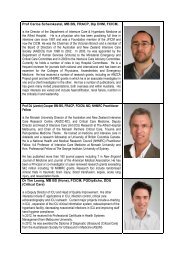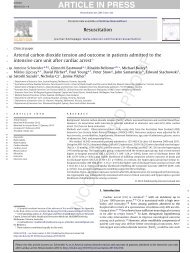Media Report
Media Portal Report - Alfred Intensive Care Unit
Media Portal Report - Alfred Intensive Care Unit
- No tags were found...
Create successful ePaper yourself
Turn your PDF publications into a flip-book with our unique Google optimized e-Paper software.
Back from<br />
the dead<br />
Aussie breakthrough<br />
revives heart patients<br />
Herald Sun, Melbourne<br />
13 May 2013, by Christian Dougherty<br />
General News, page 5 - 707.73 cm²<br />
Capital City Daily - circulation 460,370 (MTWTFS-)<br />
Copyright Agency Ltd (CAL)<br />
licensed copy<br />
back<br />
Back<br />
ID 193766211<br />
from<br />
PAGE 1 of 2<br />
Back from the dead<br />
Aussie breakthrough<br />
revives heart patients<br />
Christian Dougherty and<br />
Lucie van den Berg<br />
A VICTORIAN man who was<br />
clinically dead for 40 minutes<br />
has been brought back to life<br />
by an Australian-first resuscitation<br />
technique.<br />
Dandenong’s Colin Fiedler,<br />
39, was one of three cardiac<br />
arrest patients brought<br />
back to life after being dead<br />
for between 40 and 60 minutes<br />
at The Alfred hospital,<br />
using two new techniques in<br />
the emergency department.<br />
The Alfred is trialling a<br />
mechanical CPR machine,<br />
which performs constant<br />
chest compressions, and a<br />
portable heart-lung machine<br />
— normally used in theatre —<br />
to keep oxygen and blood<br />
flowing to the patient’s brain<br />
and vital organs.<br />
Mr Fiedler had a heart<br />
attack and was clinically<br />
dead for 40 minutes before<br />
being revived last June.<br />
‘‘I’m so grateful, more than<br />
I could ever say,’’ he told the<br />
Herald Sun.<br />
So far, seven cardiac<br />
arrest patients have been<br />
treated with the AutoPulse<br />
treated with the AutoPulse<br />
machine and extracorporeal<br />
membrane oxygenation.<br />
Three patients were successfully<br />
revived after being<br />
clinically dead for 40 to 60<br />
minutes.<br />
It allows doctors to diagnose<br />
the cause of the cardiac<br />
arrest and treat it, but<br />
keep blood and oxygen flowing<br />
to the vital organs and<br />
brain, which reduces the<br />
risk of permanent disability.<br />
Mr Fiedler is one of the<br />
three patients who were<br />
revived and returned home<br />
without disability. In the<br />
ambulance, paramedics had<br />
given him a choice of two<br />
hospitals.<br />
‘‘For some reason, I said<br />
The Alfred, which is pretty<br />
lucky because they are the<br />
only one that has it,’’ he<br />
said.<br />
Since his heart attack, he<br />
has turned over a new leaf,<br />
quitting smoking and no<br />
longer sweats the small stuff.<br />
The system is available<br />
only at The Alfred, but<br />
senior intensive care physsenior<br />
intensive care physician<br />
Professor Stephen<br />
Bernard said the results<br />
from the first two years of<br />
the trial were exciting and<br />
he hoped to eventually<br />
expand the system across<br />
Melbourne.<br />
Prof Bernard said it<br />
required three trained<br />
intensive-care physicians<br />
and all the machinery ready<br />
to go on site, which no other<br />
hospital in Victoria had.<br />
AutoPulse is available only<br />
in three ambulances, but<br />
Prof Bernard said the company<br />
that distributed the<br />
CPR machine had offered to<br />
provide more machines.<br />
‘‘We are looking to where to<br />
best implement these<br />
machines around Melbourne,’’<br />
he said.<br />
Ambulance Victoria also<br />
used the AutoPulse machine<br />
to save the life of former junior<br />
world champion swimmer<br />
Clare Carney after a cardiac<br />
arrest last year.


